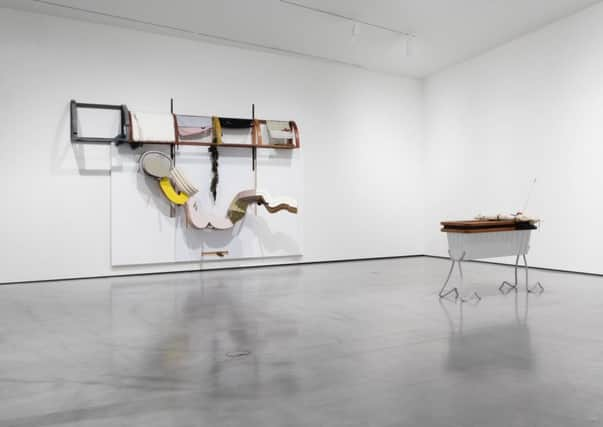Art reviews: Hepworth Prize for Sculpture | Rachel Maclean: Wot U :-) about?


Hepworth Prize for Sculpture ****
Hepworth Gallery, Wakefield
Rachel Maclean: Wot U :-) about? ****
HOME, Manchester
In an increasingly bleak landscape for Britain’s regional museums and galleries, Wakefield’s Hepworth Gallery is a beacon of hope. Opened in 2011, the gallery, which was designed by David Chipperfield Architects, looks from the outside like a cluster of concrete-box monoliths marooned on a headland of the river Calder. From the inside it is a clever series of white cubes which is carefully punctuated windows offering dramatic vistas of fast moving water on the edge of the industrial townscape. Most importantly, the gallery has a great permanent collection and, under director Simon Wallis, an exhibition programme worth shouting about.
The Hepworth is named after Wakefield’s most famous daughter, Barbara Hepworth who was born in the West Yorkshire city in 1903, and the gallery’s permanent collection includes the Hepworth Family Gift of sculptural prototypes and associated works. But it is, like the art of Hepworth herself, an outward gaze and commitment to radical and contemporary sculpture that saves it from introspection.
Advertisement
Hide AdAdvertisement
Hide AdThis winter has seen the inaugural Hepworth Prize for Sculpture hit the headlines for all the right reasons. A biennial award worth £30,000, it recognises “a British or UK-based artist of any age, at any stage in their career, who has made a significant contribution to the development of contemporary sculpture.”
Two of the nominees are senior figures: David Medalla, a gentle trickster figure from the Phillipines, who has been a quietly innovate presence in British art since the sixties and Phyllida Barlow,
currently Grande dame of messy physical sculpture who will represent Britain at the Venice Biennale next year.
The other two are younger artists: Steven Claydon, who will show in Glasgow and Bute this year, and the mercurial sculptor Helen Marten. At the ceremony in November, 31 year-old Marten won out and, in a heartfelt speech, declared she would share her winnings with the other three. If I’m not convinced that Marten was quite right for this award, which is a rare space in the art world that allows for long-term achievements and lifelong commitments, she thoroughly deserved the Turner Prize she received a just a few weeks later.
If I were asked to choose between a single visit to the Turner at Tate Britain or to Wakefield this winter, then I’d opt for Wakefield. Barlow has been given full rein with Scree Stage, a vast tilting landscape, like the surface of a particularly bleak moon, which you approach from underneath as though caving. As you weave through the grey stalagmites, it becomes apparent that this is all chicken wire and cement, sleight of hand and a kind of blunt, brute magic.
David Medalla revisits his history of participation and invention. I can never tire of Cloud Canyons, the 1964 seminal foaming bubble sculpture that made his name. If this seemed like the future, a world where sculpture would be restless, making itself as much as being made, then much of his work also hands that power over to the visitor, who in Wakefield can stitch themselves into fabric the exhibition.
Claydon’s work is allusive and elusive. The shimmering night sky you glimpse at one end of the gallery is blue-coated magnetic wall upon which copper pennies cling. You enter the space through a thick citronella fug and the kind of plastic curtain familiar from meat safes and fresh food storage. Industrial blue lights echo the lighting techniques used by fishermen to catch squid. It is all repulsion and attraction, lure and deterrent. A throb of electricity runs through much of the work, sculptures are miked up as though it might be possible to catch materials humming or the atoms whizzing through the grey matter of a sculpted head of William Morris.
Advertisement
Hide AdAdvertisement
Hide AdMarten’s work is a complex play of two and three dimensions that creates a new poetry out of unlikely materials such as straw, leather, fired clay, shell, coffee beans, cherry stones, milk cartons and cigarettes. 2017 has been her year.
If the Hepworth Prize reads the runes of both the present and future of British sculpture, then across in Manchester a major show at HOME provides a glimpse into the possibilities for Scotland’s artist for Venice this year. Last January Rachel Maclean was The Scotsman’s artist to watch and she had an excellent year, with a residency in Texas, the acquisition of her recent film Feed Me by the Scottish National Gallery of Modern Art and the Venice accolade.
Edinburgh-trained, Glasgow-based Maclean is not for the faint-hearted, with her sickly Day-Glo colours and her brutal sense of humour. At HOME I would happily do without a new set of sculptures that harvest her film iconography of smiley faced emojis and plastic tat. But her futuristic new film installation It’s What’s Inside That Counts is a nauseating joy that more than justified the trip.
Maclean harnesses digital design, pop music, prosthetics and green screen technology to capture the infantilised world of bubble gum aesthetics and celebrity image-making by which late capitalism attempts to disguise its global greed. As ever, she plays all the characters herself, including a series of disco-dancing rats who live in the sewers and gnaw on the tangled web that the internet has woven.
Her main characters in this new film are a Kim Kardashian figure whose fondness for facial contour make-up seems to have swallowed most of her face and Happy Man, a wellness guru whose rentaquote spirituality is only matched by his insatiable hunger for data. If Maclean lays bare the sorry mess of a world manipulated by its cravings for likes, shares and retweets she does so without sanctimony and with awe-inspiring investment. I can’t wait for Venice in May. ■
*Hepworth Prize for Sculpture until 19 February; Rachel Maclean, run ended